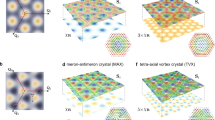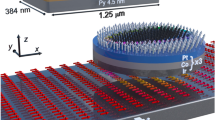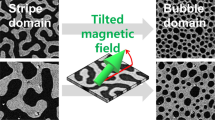Abstract
Control of topological spin textures in magnetic systems may enable future spintronic applications. Magnetic field pulses can switch the vortex polarity1 or the winding number of magnetic bubbles2. Thermal energy can reverse the helicity of skyrmions3 and induce the transformation between meron and skyrmion by modifying the in-plane anisotropy4,5. Among the various topological spin textures, skyrmions6,7 and antiskyrmions8,9,10 are nanometric spin-whirling structures carrying integer topological charges (N) of −1 and +1 (refs. 7,11,12), respectively, and can be observed in real space8,13. They exhibit different dynamical properties under current flow14,15,16,17,18, for example, opposite signs for the topological Hall effect. Here we observe, in real space, transformations among antiskyrmions, non-topological (NT) bubbles and skyrmions (with N of +1, 0 and −1, respectively) and their lattices in a non-centrosymmetric Heusler magnet, Mn1.4Pt0.9Pd0.1Sn, with D2d symmetry. Lorentz transmission electron microscopy images under out-of-plane magnetic fields show a square lattice of square-shaped antiskyrmions near the Curie temperature and a triangular lattice of elliptically deformed skyrmions with opposite helicities at lower temperatures. The clockwise and counter-clockwise helicities of the skyrmions originate from Dzyaloshinskii–Moriya interactions with opposite signs along the [100] and [010] directions, respectively. A variation of the in-plane magnetic field induces a topological transformation from antiskyrmions to NT-bubbles and to skyrmions, which is accompanied by a change of the lattice geometry. We also demonstrate control of the helicity of skyrmions by variations of the in-plane magnetic field. These results showcase the control of the topological nature of spin configurations in complex magnetic systems.
This is a preview of subscription content, access via your institution
Access options
Access Nature and 54 other Nature Portfolio journals
Get Nature+, our best-value online-access subscription
$29.99 / 30 days
cancel any time
Subscribe to this journal
Receive 12 print issues and online access
$259.00 per year
only $21.58 per issue
Buy this article
- Purchase on Springer Link
- Instant access to full article PDF
Prices may be subject to local taxes which are calculated during checkout




Similar content being viewed by others
Data availability
The data that support the findings of this study are available from the corresponding author upon reasonable request.
References
Hertel, R., Gliga, S., Fähnle, M. & Schneider, C. M. Ultrafast nanomagnetic toggle switching of vortex cores. Phys. Rev. Lett. 98, 117201 (2007).
Moutafis, C., Komineas, S. & Bland, J. A. C. Dynamics and switching processes for magnetic bubbles in nanoelements. Phys. Rev. B 79, 224429 (2009).
Yu, X. Z. et al. Thermally activated helicity reversals of skyrmions. Phys. Rev. B 93, 134417 (2016).
Yu, X. Z. et al. Transformation between meron and skyrmion topological spin textures in a chiral magnet. Nature 564, 95–98 (2018).
Lin, S. Z., Saxena, A. & Batista, C. D. Skyrmion fractionalization and merons in chiral magnets with easy-plane anisotropy. Phys. Rev. B 91, 224407 (2015).
Skyrme, T. H. R. A unified field theory of mesons and baryons. Nucl. Phys. 31, 556–569 (1962).
Nagaosa, N. & Tokura, Y. Topological properties and dynamics of magnetic skyrmions. Nat. Nanotechnol. 8, 899–911 (2013).
Nayak, A. K. et al. Magnetic antiskyrmions above room temperature in tetragonal Heusler materials. Nature 548, 561–566 (2017).
Bogdanov, A. N. & Yablonskii, D. A. Thermodynamically stable ‘vortices’ in magnetically ordered crystals. The mixed state of magnets. Sov. Phys. JETP 68, 101–103 (1989).
Camosi, L. et al. Anisotropic Dzyaloshinskii–Moriya interaction in ultrathin epitaxial Au/Co/W(110). Phys. Rev. B 95, 214422 (2017).
Koshibae, W. & Nagaosa, N. Theory of antiskyrmions in magnets. Nat. Commun. 7, 10542 (2016).
Hoffmann, M. et al. Antiskyrmions stabilized at interfaces by anisotropic Dzyaloshinskii–Moriya interactions. Nat. Commun. 8, 308 (2017).
Yu, X. Z. et al. Real-space observation of a two-dimensional skyrmion crystal. Nature 465, 901–904 (2010).
Jiang, W. et al. Direct observation of the skyrmion Hall effect. Nat. Phys. 13, 162–169 (2017).
Litzius, K. et al. Skyrmion Hall effect revealed by direct time-resolved X-ray microscopy. Nat. Phys. 13, 170–175 (2017).
Ritzmann, U. et al. Trochoidal motion and pair generation in skyrmion and antiskyrmion dynamics under spin–orbit torques. Nat. Electron. 1, 451–457 (2018).
Huang, Sying et al. Stabilization and current-induced motion of antiskyrmion in the presence of anisotropic Dzyaloshinskii–Moriya interaction. Phys. Rev. B 96, 144412 (2017).
Kovalev, A. A. & Sandhoefner, S. Skyrmions and antiskyrmions in quasi-two-dimensional magnets. Front. Phys. 6, 98 (2018).
Yu, X. Z. et al. Near room-temperature formation of a skyrmion crystal in thin-films of the helimagnet FeGe. Nat. Mater. 10, 106–109 (2011).
Dzyaloshinsky, I. A thermodynamic theory of ‘weak’ ferromagnetism of antiferromagnetics. J. Phys. Chem. Solids 4, 241–255 (1958).
Moriya, T. Anisotropic superexchange interaction and weak ferromagnetism. Phys. Rev. 120, 91–98 (1960).
Rößler, U. K., Leonov, A. A. & Bogdanov, A. N. Skyrmionic textures in chiral magnets. J. Phys. Conf. Ser. 200, 022029 (2010).
Bogdanov, A. N., Rößler, U. K., Wolf, M. & Müller, K.-H. Magnetic structures and reorientation transitions in noncentrosymmetric uniaxial antiferromagnets. Phys. Rev. B 66, 214410 (2002).
Camosi, L., Rougemaille, N., Fruchart, O., Vogel, J. & Rohart, S. Micromagnetics of antiskyrmions in ultrathin films. Phys. Rev. B 97, 134404 (2018).
Saito, M., Ishikawa, K., Taniguchi, K. & Arima, T. Magnetic control of crystal chirality and the existence of a large magneto-optical dichroism effect in CuB2O4. Phys. Rev. Lett. 101, 117402 (2008).
Ishizuka, K. & Allman, B. Phase measurement of atomic resolution image using transport of intensity equation. J. Electron Microsc. 54, 191–197 (2005).
Grundy, P. J. & Herd, S. R. Lorentz microscopy of bubble domains and changes in domain wall state in hexaferrites. Phys. Status Solidi (a) 20, 295–307 (1973).
Nii, Y., Sasaki, R., Iguchi, Y. & Onose, Y. Microwave magnetochiral effect in the non-centrosymmetric magnet CuB2O4. J. Phys. Soc. Jpn 86, 024707 (2017).
Spaldin, N. A. & Ramesh, R. Advances in magnetoelectric multiferroics. Nat. Mater. 18, 203–212 (2019).
Vansteenkiste, A. et al. The design and verification of MuMax3. AIP Adv. 4, 107133 (2014).
Kurtulus, Y., Dronskowski, R., Samolyuk, G. D. & Antropov, V. P. Electronic structure and magnetic exchange coupling in ferromagnetic full Heusler alloys. Phys. Rev. B 71, 014425 (2005).
Acknowledgements
We thank Y. Taguchi and M. Ishida for enlightening discussions and technical assistance, respectively. We thank T. Kikitsu and D. Hashizume (Materials Characterization Support Team in the RIKEN Center for Emergent Matter Science) for technical support on the TEM (JEM-2100F), which was used to obtain L-TEM images. This work was partly supported by Grants-in-Aid for Scientific Research (A) (grant no. 18H03685) and Grants-in-Aid for Scientific Research on Innovative Area ‘Nano Spin Conversion Science’ (grant no. 17H05186) from JSPS, PRESTO (grant no. JPMJPR18L5, JST) and CREST (grant no. JPMJCR1874, JST).
Author information
Authors and Affiliations
Contributions
X.Y., S.S. and Y.T. jointly conceived the project. L.P., K.N. and X.Y. carried out L-TEM observations and analysed the experimental data. R.T. synthesized the MnPtPdSn crystals and performed magnetic property measurements. W.K., K.S., T.-H.A. and N.N. performed the simulations. L.P., X.Y., W.K., N.N., S.S. and Y.T. wrote the manuscript. All authors discussed the data and contributed to the manuscript.
Corresponding authors
Ethics declarations
Competing interests
The authors declare no competing interests.
Additional information
Peer review information Nature Nanotechnology thanks Lorenzo Camosi, Mathias Kläui and the other, anonymous, reviewer(s) for their contribution to the peer review of this work.
Publisher’s note Springer Nature remains neutral with regard to jurisdictional claims in published maps and institutional affiliations.
Extended data
Extended Data Fig. 1 Lattice forms of antiskyrmions simulated by using Landau–Lifshitz–Gilbert equation.
Simulated square lattice (a) and hexagonal lattice (b) of antiskyrmions with using the energies of the exchange energy (A), D2d-type DMI, Zeeman energy, uniaxial anisotropy energy (Ku), and demagnetization energy for a and the energies including A, DMI, and Zeeman energy for b, respectively. The colour wheel in b and the triangles in a-b indicate the direction of in-plane magnetizations of the magnetic textures, whereas the dark colour indicates out-of-plane magnetizations.
Extended Data Fig. 2 Simulated L-TEM images of antiskyrmion, NT-bubble, and skyrmion.
Magnetic textures (a, d, g), simulated (b, e, h) and experimental (c, f, i) L-TEM images of a-c square-shape antiskyrmion, d-f NT-bubble, and g-i elliptic skyrmion. The colour bar indicates the normalized components of out-of-plane magnetizations in magnetic textures.
Extended Data Fig. 3 Sequential L-TEM images during the transformation process between the square antiskyrmion lattice and the triangular NT-bubble lattice.
A series of L-TEM images with varying the in-plane field along a, \([0\bar 10]\) and [010], b, \([\bar 100]\) and [100] directions showing the transformation between antiskyrmion lattice and NT-bubble lattice through a mixed state of antiskyrmions and NT-bubbles in a reproducible way. The order of L-TEM observations is shown as the red arrows.
Extended Data Fig. 4 T-H phase diagram of various magnetic textures together with several L-TEM images observed in the (001) MnPtPdSn thin plate.
a, Phase diagram and L-TEM images of isolated antiskyrmions and skyrmions under the normal field. b, Phase diagram and L-TEM image of NT-bubbles under the tilting field with 15° relative to the \([00\bar 1]\) axis. Various phases of I,II, III, VI, VII and VIII have been described in the right panels of a, b. The field directions are indicated in the upper-right images of a, b. The open circles specify the (T, µ0H) points, where we have done the L-TEM observations.
Supplementary information
Supplementary Information
Supplementary Figs. 1–4 and Discussion.
Supplementary Video 1
Numerical simulation showing dynamics of skyrmion-to-NT-bubble transformation.
Supplementary Video 2
Numerical simulation showing dynamics of skyrmion-to-NT-bubble transformation.
Rights and permissions
About this article
Cite this article
Peng, L., Takagi, R., Koshibae, W. et al. Controlled transformation of skyrmions and antiskyrmions in a non-centrosymmetric magnet. Nat. Nanotechnol. 15, 181–186 (2020). https://doi.org/10.1038/s41565-019-0616-6
Received:
Accepted:
Published:
Issue Date:
DOI: https://doi.org/10.1038/s41565-019-0616-6
This article is cited by
-
Multistep topological transitions among meron and skyrmion crystals in a centrosymmetric magnet
Nature Physics (2024)
-
Experimental observation of current-driven antiskyrmion sliding in stripe domains
Nature Materials (2024)
-
Heat current-driven topological spin texture transformations and helical q-vector switching
Nature Communications (2023)
-
Lifetime of coexisting sub-10 nm zero-field skyrmions and antiskyrmions
npj Quantum Materials (2023)
-
Transition between distinct hybrid skyrmion textures through their hexagonal-to-square crystal transformation in a polar magnet
Nature Communications (2023)



